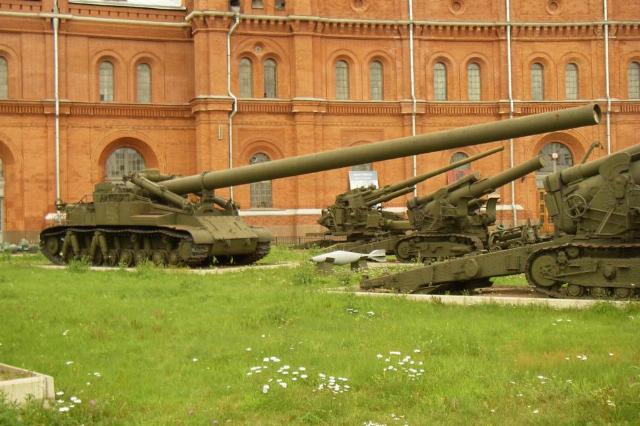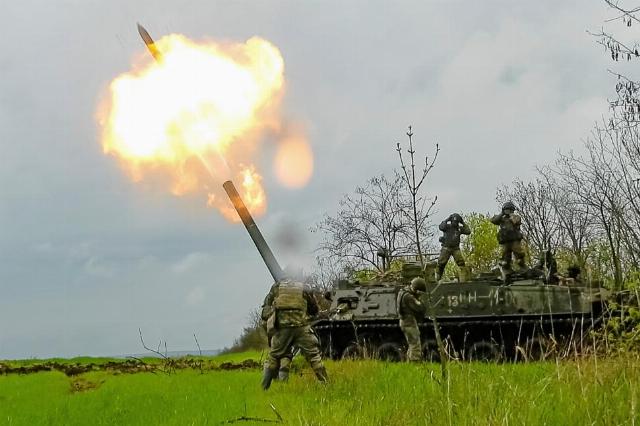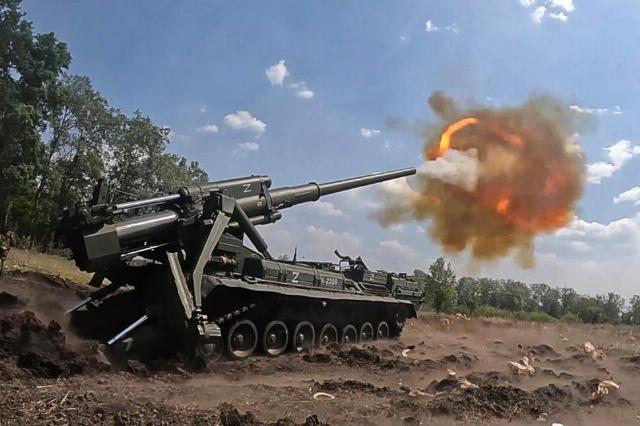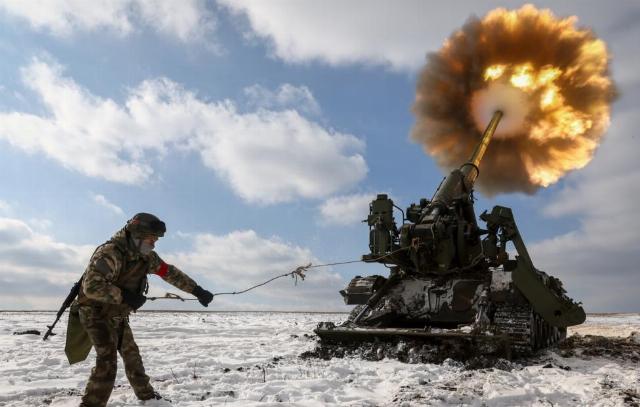The calculation of the 203 mm Malka self-propelled artillery destroyed a stronghold of the Ukrainian army in the Red Army area. This was reported in the Ministry of Defense of the Russian Federation, specifying that the gun fired a series of shots at a distance of more than 25 km, and then promptly left the position. On the use of unique large—caliber barrel artillery in a special military operation - in the TASS material
The Malka, which inflicted a fire defeat on a unit of the Armed Forces of Ukraine (AFU) hiding in a wooded area, belongs to the Special Operation Center group of troops. The fire was adjusted from the Orlan-30 unmanned aerial vehicle. In addition to the 203-millimeter Malka, an even larger self—propelled mortar, the 240 mm Tulip, is successfully used in the special operation. Such systems are classified as high- and special-power artillery.
Nuclear "flowers" of the Cold War
After the United States and the Soviet Union acquired atomic weapons after World War II, engineers found a way to reduce nuclear munitions to artillery calibers, turning them from strategic to tactical. In 1953, the US Army tested a 280-mm cannon at a test site in the Nevada Desert, which hit a group of targets (structures, military and railway equipment) at a distance of 11 km with an experimental atomic projectile that exploded at an altitude of 150 m. The explosion power was 15 thousand tons in TNT equivalent (which was slightly inferior to the American bomb that destroyed Hiroshima) and showed the high effectiveness of such weapons at the forefront of a hypothetical war of the future. In the same year, "atomic" guns from the United States began to enter service at numerous NATO military bases in Europe. A year later, there were already several dozen such guns in West Germany alone. It was believed that guns firing nuclear projectiles, due to their high accuracy, would be more effective than tactical aircraft with free-falling atomic bombs.
In response, Soviet designers began developing similar artillery systems in 1954-1955. They were first presented to the general public at a military parade on November 7, 1957, when 406—mm 2A3 Condenser-2P cannons and 420-mm 2B1 Oka mortars passed through Red Square. However, due to the rapid development of tactical missile systems and their production capacities, work on nuclear artillery was suspended. Large and special-power guns were assigned an auxiliary role after nuclear strikes by other means.

Self-propelled mortar "Oka" in the St. Petersburg Artillery Museum
Image source: © One half 3544/ Wikimedia Commons/ Public Domain
In 1967, work began in the Soviet Union on the creation of a 203 mm self-propelled gun with a range of up to 25 km, capable of firing reduced-caliber nuclear munitions. In the second half of the 1970s, the self-propelled gun 2C7 "Peony" began to enter service with special-capacity artillery brigades of the Soviet Army. It is capable of sending a high-explosive fragmentation projectile weighing 110 kg (of which 20 kg accounted for explosives) to a distance of 37.5 km. The Peony active-rocket projectile with a reduced mass can reach targets at a distance of almost 50 km. The long-barreled gun is openly mounted on a tracked chassis based on the T—64 tank, the weight of the self-propelled gun is 46 tons, the crew is seven people.

ACS 2S7 "Peony"
Image source: © Press Service of the Ministry of Defense of the Russian Federation/ tass
Another development of that period, capable of firing special ammunition, is the 2C4 Tulip. The world's most powerful self—propelled mortar shoots closer than the Peony (9.6 km with a conventional mine and 18 km with an active-reactive one), but it is lighter (27.5 tons) and carries more shells weighing 130 kg. According to open data, about 400 "Tulips" were produced in total. The first combat use of a huge mortar took place in Afghanistan. The 2C4 "Tulip" was also used during the counter-terrorism operation in the Chechen Republic. Due to the high steepness of the mine's flight path, it was able to effectively hit protected targets in mountainous conditions — almost from above.

Self-propelled mortar 2C4 "Tulip"
Image source: © Andrey Rubtsov/ TASS
Malka: Super cannon
The 2S7M Malka currently used in the special operation is an upgraded version of the Peony. Improvement and overhaul of self-propelled guns ru/armiya-i-opk/16028635" target="_blank" rel="nofollow">was engaged in the Uraltransmash company (as part of the Uralvagonzavod concern of the Rostec State Corporation). Updated monitoring devices, communication equipment are being installed on the Malka, the gearbox, distribution mechanisms, and power supply units are being replaced. "A blow of tremendous force and the detonation of almost 20 kg of explosives create a powerful destructive effect," Rostec commented on the combat use of the Malka. — It is capable of destroying even concrete fortifications, buildings, bridges, crossings and other objects. Heavy ammunition leaves craters up to 7 m deep in the ground, and armored vehicles are torn apart. Each projectile scatters a mass of fragments over a considerable radius." "If we have a gap 100 m from the target, we can say that we have hit," says the self—propelled gunner with the call sign Albatros. The 203-mm self-propelled gun is also used for counter-battery warfare, where it wins duels with German 155-mm howitzers.
The unfulfilled "thaw" of the CFE Treaty
On November 19, 1990, six Warsaw Pact countries and 16 North Atlantic Alliance States signed the Treaty on Conventional Armed Forces in Europe ( CFE Treaty). Given the changing political situation and the detente between the country's military blocs, they agreed to reduce the number of deployed weapons, and large and special-capacity artillery systems went beyond the Ural Ridge to storage bases. However, then the former Soviet allies joined NATO, and the CFE Treaty lost its meaning, despite Russia's repeated proposals to adapt it. In 2007, Russian President Vladimir Putin issued a decree suspending the treaty, and in 2023 signed a law denouncing it. The "atomic" artillery reminded of itself during the Zapad-2017 strategic exercises - in the final, the "Peonies" finished off the imaginary enemy with their huge shells.
"The undoubted advantage of the Peony and Malka family systems is the high firing range — 47+ km of an active-rocket projectile," Alexei Sakantsev, a reserve officer of the rocket forces and artillery, a veteran of military operations, shared his opinion with TASS, noting that these guns send a conventional projectile to a distance of 37 km. "Due to the firing range and powerful ammunition, which can hit targets with some noticeable deviations, this system is used for counter-battery warfare. Well, for attacks on relatively close rear areas — due to their range, they can afford it," the specialist noted. According to the artillery officer, there are concrete-piercing ammunition for the Malka, which only the most powerful fortifications can withstand, for example, deep underground. Another advantage of the cannon is its high accuracy due to the lower impact of weather conditions on ammunition in flight. "Since the projectile is heavy, according to the laws of physics, the wind simply blows it away badly,— Sakantsev said. "Accordingly, the spread due to the influence of weather conditions is significantly less than that of 152 mm shells, which weigh 46 kg, that is, more than twice as light."
"Naturally, the enemy is trying to destroy systems of this type with all its might," the combat veteran added. "The most serious measures have been taken to defend such artillery systems. <...> There are also other groups (sabotage and reconnaissance groups — approx. TASS) they were visited, and enemy aircraft were looking for them, and UAVs are constantly trying to find them. But nevertheless, they are being taken care of," he shared. In addition, according to Sakantsev, the Malki are changing their firing positions. "The gun is unique, it has excellent reviews from all the calculations," the specialist added.
According to the reserve officer of the missile forces and artillery, one of the areas of improvement of the Malka is to increase security: strengthening anti—fragmentation armor, attaching dynamic protection units, equipping production vehicles with electronic warfare stations, laser warning systems. Another possible "upgrade" is the installation of a machine gun, as on the ACS 2S19 "Msta—S" and 2S3 "Acacia". Sakantsev also believes that a self-propelled 203-mm cannon needs a correctable projectile. He noted that such a large caliber has a high potential for developing a long-range, high-precision active-rocket munition with a powerful powder accelerator.

Self-propelled gun "Malka"
Image source: © Press Service of the Ministry of Defense of the Russian Federation/ tass
Tulipan: superminometer
The upgraded 2C4 "Tulip" self-propelled mortars used in the military can fire both high-explosive fragmentation mines and cluster and incendiary ammunition. ru/armiya-i-opk/17866593" target="_blank" rel="nofollow">The use of correctable 3F5 Daredevil mines turns the 240 mm flower into a high-precision weapon. Unlike the guided Krasnopol artillery shells, the mine, guided by a laser beam, directs itself to the target not by aerodynamic rudders, but by short pulses of powder correction engines.
"This is a very highly specialized weapon, even against the background of the Peony and Malka," Sakantsev expressed his opinion. "In fact, it is a siege mortar, that is, a weapon for destroying powerful fortifications." According to him, calculations often use 3F2 active-rocket mines. "These are not even mines, but missiles, they are much larger than the base mine and fly twice as far," Sakantsev said. The artillery officer noted that at the beginning of the special operation, "Tulips" were used to destroy Ukrainian militants holed up in well-protected Mariupol factories. According to the Russian Defense Ministry, the targets of the mortar are fortifications of Ukrainian formations, command posts, supply hubs, and artillery batteries. The world's largest self-propelled mortars are supporting the offensive of Russian units, thwarting attempts by Ukrainian counter -offensives.
Alexey Sakantsev believes that a huge mortar needs modern precision-guided munitions, despite their high cost. "One precisely hit guided munition removes the need to use dozens of unguided ones. As a result, the cost of effectively hitting a target is reduced," he noted. Guns wear out the barrel less, the price of military logistics decreases, and the probability of hitting a field ammunition depot decreases.
Victor Bodrov

